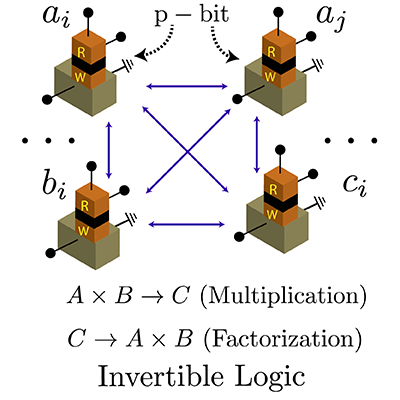Scientists Present a New Magnet-based Computing Architecture
 Digital electronics are based on deterministic units
Digital electronics are based on deterministic unitscalled bits that can have one of two values, 0 and 1.
New theoretical work suggests that circuits built out of
probabilistic units that fluctuate randomly in value
between 0 and 1 can be used to perform multiple
functions: A multiplier, for example, canalso function
as a factorizer.
Ultra-small stochastic magnet arrays can implement precise arithmetic calculations like digital computers, but invertibly, they argue.
(07/20/2017) In a new paper for the prestigious Physical Review X journal, a group of C-SPIN researchers from Purdue led by Professor Supriyo Datta argue that existing ultra-small magnets can be arrayed at room temperature with present-day technology to perform precise arithmetic calculations. Unlike a traditional semiconductor-based computer, however, they can also perform inverse operations: a multiplier, for example, can also function as a factorizer.
“Spintronic materials and phenomena have seen rapid progress in the past decade, but no clear candidate has emerged as a ‘drop-in’ replacement for CMOS technology” says Datta. “Instead, researchers are focusing on spintronics to provide novel functionalities that do not come easily to CMOS. This work presents what we hope is an attractive vision along these lines.”
The system Datta’s team developed – called Probabilistic Spin Logic, or PSL – builds on Boltzmann machines, which are a key part of recent advances in machine learning. “Starting from a building block, which we call the p-bit, that takes probabilistic values between a ‘0’ and ‘1,’ we presented a hardware implementation for an ‘invertible’ Boolean logic,” explains Kerem Camsari, the first author of the paper. “The new functionality is that an adder circuit can operate as a subtractor, and a multiplier circuit can operate as a divider – and this can be important since many computational problems are known to be harder when going in one direction than the other.”
“This work further confirms the importance of spintronics research for the future of computing,” says Dr. Jian-Ping Wang, Director of C-SPIN. “This work was triggered by the synergy CSPIN facilitated between materials and device researchers working on nanomagnets and magnetic tunnel junctions and researchers working on circuits and architectures. We expect that the article will inspire materials scientists and engineers to develop actual p-bits for testing and, eventually, actual computing devices.”
Ken Hansen, the CEO of Semiconductor Research Corporation, which sponsors C-SPIN, notes that “We launched C-SPIN as a source of continued innovation. The framework presented here by Professor Datta’s team clearly describes a novel way of probabilistic spin computing that can complement and scale traditional Boltzmann machines.”
The article appeared July 20 here. To learn more about the article for Physical Review X, contact Kerem Camsari, kcamsari@purdue.edu.


